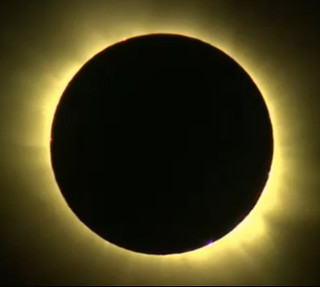Future Mars will grind its largest moon into a dusty ring

A future look at a ringed Mars. Credit: Tushar Mittal using Celestia 2001-2010, Celestia Development Team.
Meteorologist/Science Writer
Wednesday, November 25, 2015, 5:28 PM - Phobos is doomed to be turned into a dusty ring around Mars someday and the gold and platinum we value so much may be responsible for the rarity of eclipses! It's What's Up In Space!
Ring around the Red Planet?
Phobos is doomed.
Every year, the larger of Mars' moon's gets a little bit closer to the planet, and thus a little bit closer to the Roche limit - the distance between the planet and the moon where tidal forces between the two become strong enough to tear the moon apart.
When this happens, it will be ground down into rocks and dust, forming a ring around the planet, similar to what's shown in the (simulated) image above.
According to Berkeley News:
While the largest chunks would eventually spiral into the planet and collide at a grazing angle to produce egg-shaped craters, the majority of the debris would circle the planet for millions of years until these pieces, too, drop onto the planet in ‘moon’ showers, like meteor showers.
The trick to this, though, is knowing exactly how strongly the moon is held together, so that you can say with certainty exactly how far out Mars' Roche limit is. Why is this important? Where Phobos is when it starts to be ground down into dust will affect exactly how long the ring will persist, and exactly how much of the material ends up raining down on Mars.
"If the moon broke apart at 1.2 Mars radii, about 680 kilometres above the surface, it would form a really narrow ring comparable in density to that of one of Saturn's most massive rings," said study co-author and graduate student Tushar Mittal, according to Berkeley News. "Over time it would spread out and get wider, reaching the top of the Martian atmosphere in a few million years, when it would start losing material because stuff would keep raining down on Mars."
Exactly how long do we have to wait to see this happen? It's going to be sometime in the next 20-40 million years, so don't hold your breath.
Rarity of eclipses traced to Earth's gold and platinum
Here are two facts: 1) Out of the 13 full moons and 12 new moons in 2015, we saw only two solar eclipses and two lunar eclipses here on Earth. 2) Earth's crust has a strangely high abundance of precious metals, such as gold and platinum.
|
|
What do these two facts have in common? Everything, according to Kaveh Pahlevan and Alessandro Morbidelli, researchers at Laboratoire Lagrange, Université Côte d’Azur, in Nice, France.
Of all the moons in the solar system that are reasonably close to their planet - closer than about 10 million km, let's say - the vast majority of their orbits lie pretty much right along the planet's equator. If Earth's moon was among this majority, each full moon would be a lunar eclipse and each new moon would produce a solar eclipse. However, since the Moon has an orbit that is tilted by about 5 degrees from the Earth's equator, most of the time the shadows miss, and on average we only see four eclipses each year - two solar and two lunar.
The reason for this tilted orbit, and thus the relative rarity of eclipses, has been something of a mystery.
Based on a study they recently published in the journal Nature, Pahlevan and Mobidelli say that since gold and platinum are heavy metals, they would have sunk towards Earth's core as the planet formed. Thus, the abundance of gold and platinum in Earth's crust can only have resulted due to impacts from asteroids rich in those metals. Their model simulations point to this happening by a slew of impactors, each of which was fairly small taken individually, but added up, their mass, and thus gravity, would have been enough to tug on the Moon as they entered the Earth-Moon system.
In total, the number of asteroids that would account for these heavy metals in Earth's crust is between 60 to 120 per cent of the mass of the Moon, and their interactions with the Moon would have been enough tilt the axis of its orbit by around 10 per cent to start. From there, once the near-Earth environment quieted down, the interactions between the Moon, the Earth and the Sun eventually reduced that inclination down to what it is today.
Sources: UC Berkeley | Science
Related Video: Watch this awesome time-lapse of the Sept 27, 2015 Supermoon Total Lunar Eclipse



